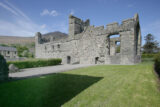Notice
Carlingford Friary is a state-owned National Monument in the care of the Office of Public Works
*Limited parking available near site*
WARNING: It should be noted that these sites are unguided and a level of care and caution should be maintained during all stages of your visit. The Office Of Public Works (OPW) will not be held responsible for any damages, injuries, or losses that occur
Carlingford Dominican Friary
Carlingford Dominican Friary was founded by the Dominican Order in 1305 under the patronage of Richard Óg de Burgh (1259-1326), the 2nd Earl of Ulster, who was known as The Red Earl. It was dedicated to Saint Malachy (1095-1148). De Burgh was one of the most powerful Irish nobles of the late 13th and early 14th centuries and was father of Elizabeth, wife of King Robert the Bruce of Scotland.
Lying in a traditional east/west orientation, and measuring 38 meters by 6.7 meters (125 feet by 22 feet) inside, remaining at Carlingford is the Friary’s church with its nave and chancel, divided by a central bell-tower, the latter being built of rough-coursed limestone and a hard, dark limestone known as greywacke. This tower is considered by some architectural historians to be a part of the original structure, though others claim that it is a later 15th century addition.
Immense pointed widows, some now filled in, once illuminated the church’s interior, as did the large and elegant Gothic-arched eastern window. The other usual parts of such a Dominican ecclesiastical site, such as the sacristy, the muniment house, the chapter house and the cloister have all long-since disappeared.
Crenelated parapets were added to ramparts on the full length of the tops of each of the church’s north and south walls, and in 1423 two crenelated defensive towers were added to the north and
south corners of the austere west gable, all giving the church its unusual fortified appearance. A murder hole can still be clearly seen above the pointed cut-stone entrance doorway in this façade.
Perpendicular to and to the south of the church’s chancel are the outline remains of an east range, at the south end of which are the ruins of a 15th or 16th century tower. The site remained in ecclesiastical use until the Dissolution of the Monasteries was ordered by King Henry VIII of England in 1539.
During the early years of the Cromwellian era of the 1650s, Murrough MacDermod O'Brien, 1st Earl of Inchiquin (1614-1673), known as “Murrough the Burner”, used the friary as a barracks and a stable for his soldiers and their horses.
In 1671, under King Charles II of England, the friary was to reopen, but ownership was disputed by the Franciscan Order. On the heels of a visitation and investigation by Oliver Plunkett, then Catholic Archbishop of Armagh, he recommended that it be returned to Dominicans, which ownership was eventually confirmed by a Papal Decree in 1678.
By 1731 there were no friars living in Carlingford and the friary relocated to Dundalk in 1767. The church belfry’s fine-toned bell was eventually removed and sold in Liverpool in the 19th century. Over the intervening centuries the friary’s buildings were used for a hall, a barracks, a base for herring fishermen and as a handball alley.
Visit Historic Environment Viewer for more information on Carlingford Dominican Friary
Protect our Past - Click here to read about the importance of protecting our country’s unique heritage sites
This national monument is protected in accordance with the National Monuments Acts 1930 to 2014
Gallery

Walk to Carlingford Credit Photographic Archive, National Monuments Service, Government of Ireland 
The inner centre of the Abbey Credit Photographic Archive, National Monuments Service, Government of Ireland 
Side profile of the Abbey Credit Photographic Archive, National Monuments Service, Government of Ireland
Nearby sites to visit
Carlingford Castle
A Norman citadel in the shadow of a giant
Approx. 0.6 km from Carlingford Dominican Friary
Old Mellifont Cistercian Abbey Monastic Site
Visit Ireland’s very first Cistercian foundation
Approx. 37.6 km from Carlingford Dominican Friary
Battle of the Boyne Visitor Centre – Oldbridge Estate
Where two kings fought for Europe’s future
Approx. 38.2 km from Carlingford Dominican Friary
Brú na Bóinne Visitor Centre: Newgrange, Knowth and Dowth
Step into Ireland’s richest archaeological landscape
Approx. 42.1 km from Carlingford Dominican Friary
Hill of Tara
Experience the legacy of the high kings
Approx. 58.3 km from Carlingford Dominican Friary
Trim Castle
The ultimate symbol of Norman glory
Approx. 66.9 km from Carlingford Dominican Friary

